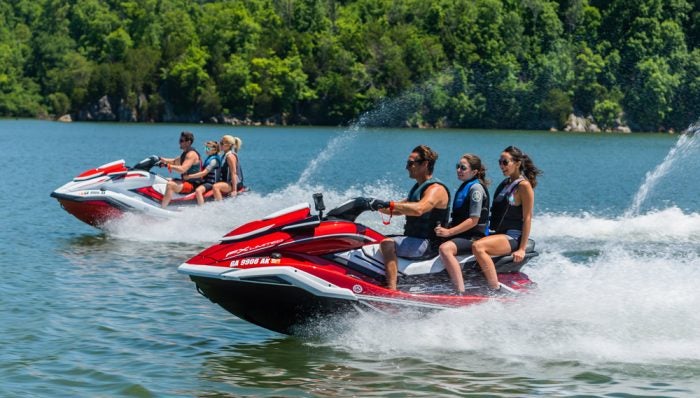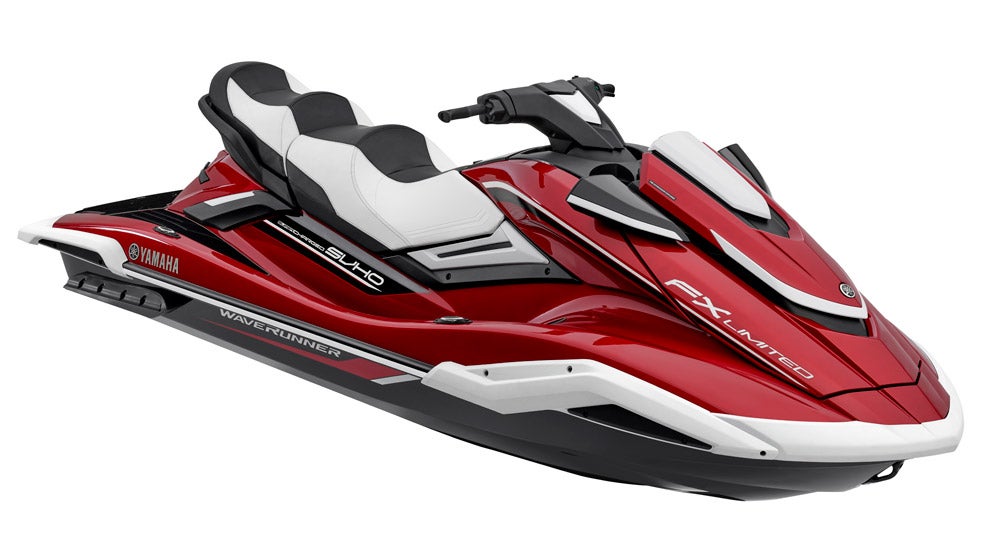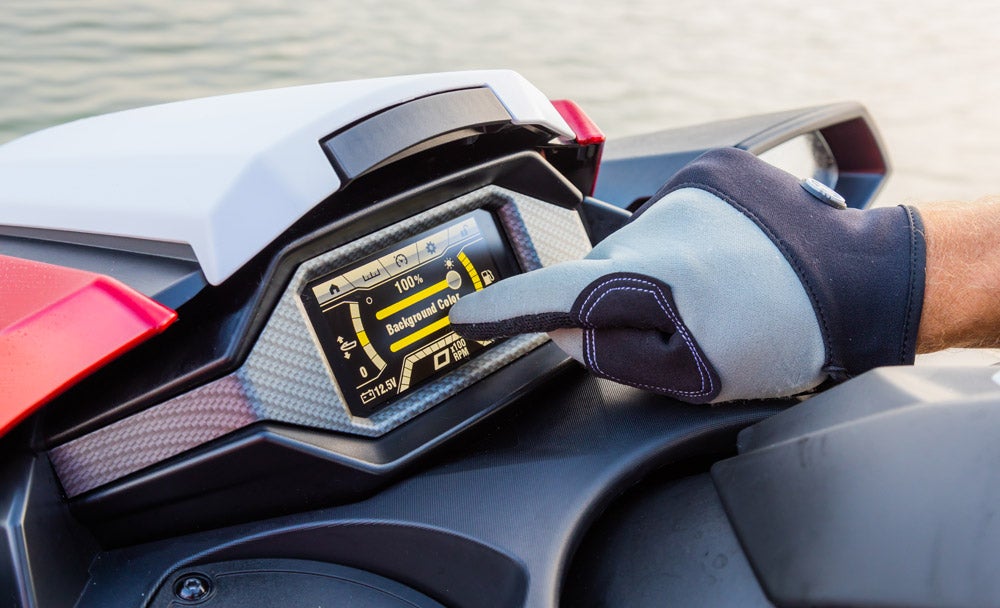2019 Yamaha WaveRunner Lineup

The 2019 Yamaha WaveRunner lineup has been released and is highlighted by the completely redesigned FX platform and new EXR.
A new hull and deck. A color touchscreen display along with multiple new ways to fine tune your craft’s response. A simple, affordable, yet innovative way to add a variety of accessories and truly personalize your craft, whether your interests be music, capturing video, or getting serious about fishing. All describe the new 2019 Yamaha FX platform unveiled to dealers on August 14, 2018, and previewed to the press weeks earlier outside Atlanta along with the rest of the 2019 Yamaha WaveRunner lineup.
Other highlights from Yamaha’s 2019 model year plans? A souped-up EX model that promises to bring even more fun and performance to the Rec Lite category, tweaks to the existing GP1800 and VXR, and a commercial-oriented craft aimed squarely at rental operators.
We’ve not only got the inside scoop…but significant seat time on the brand’s hottest models.
Meet The All-New FX…

Initial reports of the FX series makeover had the feel of marketing hype, but it’s fair to say the boats encountered at the 2019 Yamaha WaveRunner sneak peak for the press far exceeded expectations. These weren’t superficial makeovers as much as bottom-to-top redesigns.
Start with the hull. Based off of the sporty GP1800, the 10” longer FX rewards an intuitive inside lean with a predictable, twitch-free carve through the most aggressive of turns. Yes, I felt the GP influence (and the benefits of a top-loader scoop grate) but for the driver it’s not as demanding a ride as the muscular GP. Still, the craft delivers much the same end result. Turns are quick, sharp and precise. Straight-ahead stability is top notch, in rough and calm water. And yet, the process is not as strenuous on your body as the GP can be. The intuitive inside lean naturally takes a lot of strain off the upper body, allowing the rider to flow with the craft rather than fight it through the turns.

Mated to that hull is a deck that, while certainly familiar, is also unique. Bond rails are dressed up with angular trim pieces that give the craft more aggressive lines in profile. The once dominant triangular bow compartment door and its integrated mirrors has been streamlined dramatically for a fresh new look. Practical additions hide beyond the exterior. Bow storage is expanded to 30.3 gallons (up from 21.4) and now includes a designated spot for a removable cooler bag; the glovebox interior expands beyond the opening for far greater room internally (4.65 gallons total compared to the former 1.8) and is now watertight; and the footwells bring back a feature we haven’t seen since the four-passenger SUV — drains. They prevent water from filling the footwells while riding, but also drain rainwater away when the craft is sitting outside waiting for that next journey.

The information display has also received a significant upgrade. It’s now a 4.3” color touchscreen display and the gateway to several new features. Current fuel consumption can now be easily displayed, acceleration/top speed profiles can be chosen to fit the task at hand (such as accelerating harder when leveraging a skier out of the water and maintaining a set running speed), a top speed limit can be applied, and a four-number code chosen to lock out the ignition (replacing the former keyfob-style remote). Additional control tweaks include the ability to bump no-wake mode up or down slightly (handy when trying to stay at the same pace with another rider whose craft idles at a different speed), apply an added burst of thrust in reverse to ease backing off the trailer, activating an “ultra-low-speed” mode for more precision control in tight docking situations, and a start button that doesn’t need to be held down but simply pressed once to start the ignition process.
Below the bondline the boarding step has also been redesigned to extend deeper into the water and features an actual flat step that, when in the up position, seamlessly integrates into the aft deck.

The feature that will probably attract the most attention, however, is a relatively simple one — industry-standard RAM accessory mounts that fit into the cupholders forward of the handlebars. By choosing an existing standard like RAM, Yamaha has opened the doors to a variety of accessories that will truly let the rider customize the craft to their choosing. My test craft was set up with very affordable EcoXGear Bluetooth speakers that link to your smartphone to provide tunes on demand, offer hands-free calling via Apple’s Siri or similar, and can be easily taken off the craft when the party moves to the beach or dock. The RAM mounts can also easily connect a GoPro-style action camera, Garmin GPS fishfinder (with included transducer), or any number of accessories the aftermarket is sure to come up with. The beauty of the RAM mount system is that all can also be completely removed from the craft when desired. FX Limited SVHO models will come with an accessory package that includes a pair of speakers, the Garmin and all RAM mounting hardware. Any of these accessories can be added to the 2019 Yamaha WaveRunner FX, FX Cruiser HO, FX SVHO and FX Cruiser SVHO.
Get Ready For The EXR

Elsewhere in the 2019 Yamaha WaveRunner lineup, the supercharged GP1800 receives a new high-performance top-loader intake grate and longer “race-redesigned” ride plate that promises sharper handling and better hookup, the VXR likewise gets a similar top-loader grate/rideplate hookup matched to its smaller 155mm pump, and the naturally aspirated VXR gets lighter via an upgrade to the NanoXcel 2 hull and deck material.
Two new models also make their debut. The VX-C is aimed at the rental market, and lowers the price by leaving off RiDE and a boarding step. Arguably more exciting for the consumer market is the EXR, described as a “pocket rocket” by company insiders. An ECU change gives the 1,049cc TR-1engine more power, and the NanoXcel 2 construction method lowers weight by 70 pounds (total weight 529 pounds) for a far better power-to-weight ratio. The EXR also gets a top-loader grate and set-back pump design. Top speed increases by about four miles-per-hour to the 54 mph range. The fun factor increases in turn, with the craft taking on a powerful, playful attitude.
Get PersonalWatercraft.com in your Inbox!
Like PersonalWatercraft.com on Facebook
Comments
Most Popular

2025 Yamaha JetBlaster PRO 2-Up Review

Remembering the Sea-Doo XP

2024 Kawasaki Jet Ski STX 160X Review

Whatever Happened to the Wetbike?

2025 Yamaha JetBlaster Review













 Your Privacy Choices
Your Privacy Choices